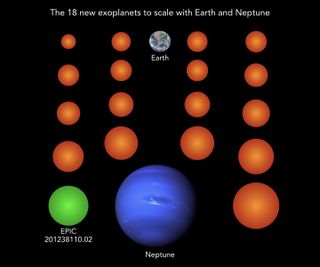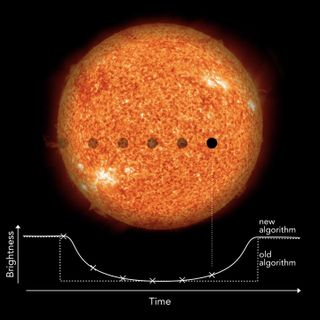Hidden Planets in Our Galaxy: 18 Terrestrial Planets Discovered

This diagram shows the newly discovered exoplanets compared to the Earth and Neptune. (Photo Credit: NASA/JPL (Neptune) NASA/SOAA/GSFC/Suomi NPP/ Norman Kuring (Earth), MPS/Rene Heller)
Using the Kepler Telescope, Scientists have collected data on 18 exoplanets. Most of the planets discovered orbit close to their parent star and have varying surface temperatures that exceed more than 1,800 degrees Fahrenheit (1000 Degrees Celsius). One planet in particular orbits a red dwarf star in the area scientists dubbed "the habitable zone". The habitable zone is the area in which a planet could host liquid water on its surface, as it orbits its parent star but this does not mean that life could flourish on this planet. This world would be particularly difficult for life to develop on due to the fact that red dwarfs emit strong x-rays that make it hard for even the hardiest of microbes to develop.
K2 is the computer program developed by scientists where Kepler space telescope uses solar winds to stabilize the telescope's pointing in a direction, examining a field of view for months. Using this method, Kepler has examined more than 100,000 stars, including 517 stars with planets orbiting them. Among the planets discovered using this method was the famous TRAPPIST-1 system (CLICK HERE: to read more about TRAPPIST-1). Researchers decided to look at the data gathered with this method using a new data processing algorithm.
Rene Heller, an astrophysicist at the Max Planck Institute for Solar System Research stated "In reality, however, a stellar disk appears slightly darker at the edge than in the center. When a planet moves in front of a star, it therefore initially blocks less starlight than at the mid-time if the transit. The maximum dimming of the star occurs in the center of the transit just before the star becomes gradually brighter again."

Kepler data identifies the exoplanets by spotting small dips in brightness caused when a planet passes between a star and the telescope. Scientists are developing new algorithms to try and uncover more planets within the data.
(Image: NASA/SDO (Sun), MPS/Rene Heller)
The reason why this new algorithm was created was to try and create a more realistic dimming pattern as a planet transits across the face of a star. Using this new algorithm it became easier to detect smaller planets. The new planets discovered range from just slightly smaller than the Earth to nearly double the size of the Earth. The new algorithm even makes it easier for scientists to discover planets when fluctuations of light from a star is altered by sunspots.
If we continue to use this algorithm and discover newer ways to interpret the Kepler data, more planets could be out there, waiting to be discovered. Who knows, some may even harbor life.
Thank you for reading and I would appreciate if you checked out my social media below! Also on the right-hand side of your screen is a Follow button! If you liked what you read, please share with your friends! If you want to see more, follow my blog so you can be updated when I make a post!
Twitter @SpaceTalk365
Facebook SpaceTalk365
For more click here!!! Home Page: Spacetalk365

No comments :
Post a Comment